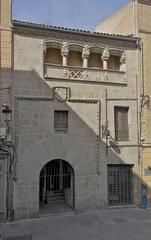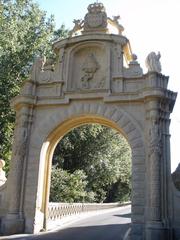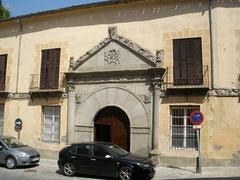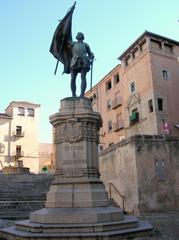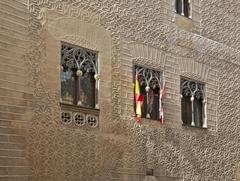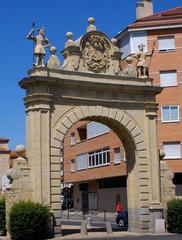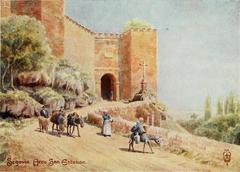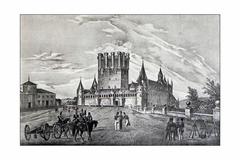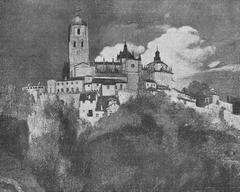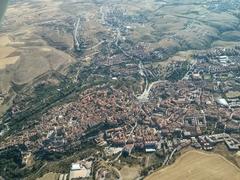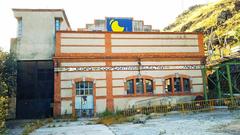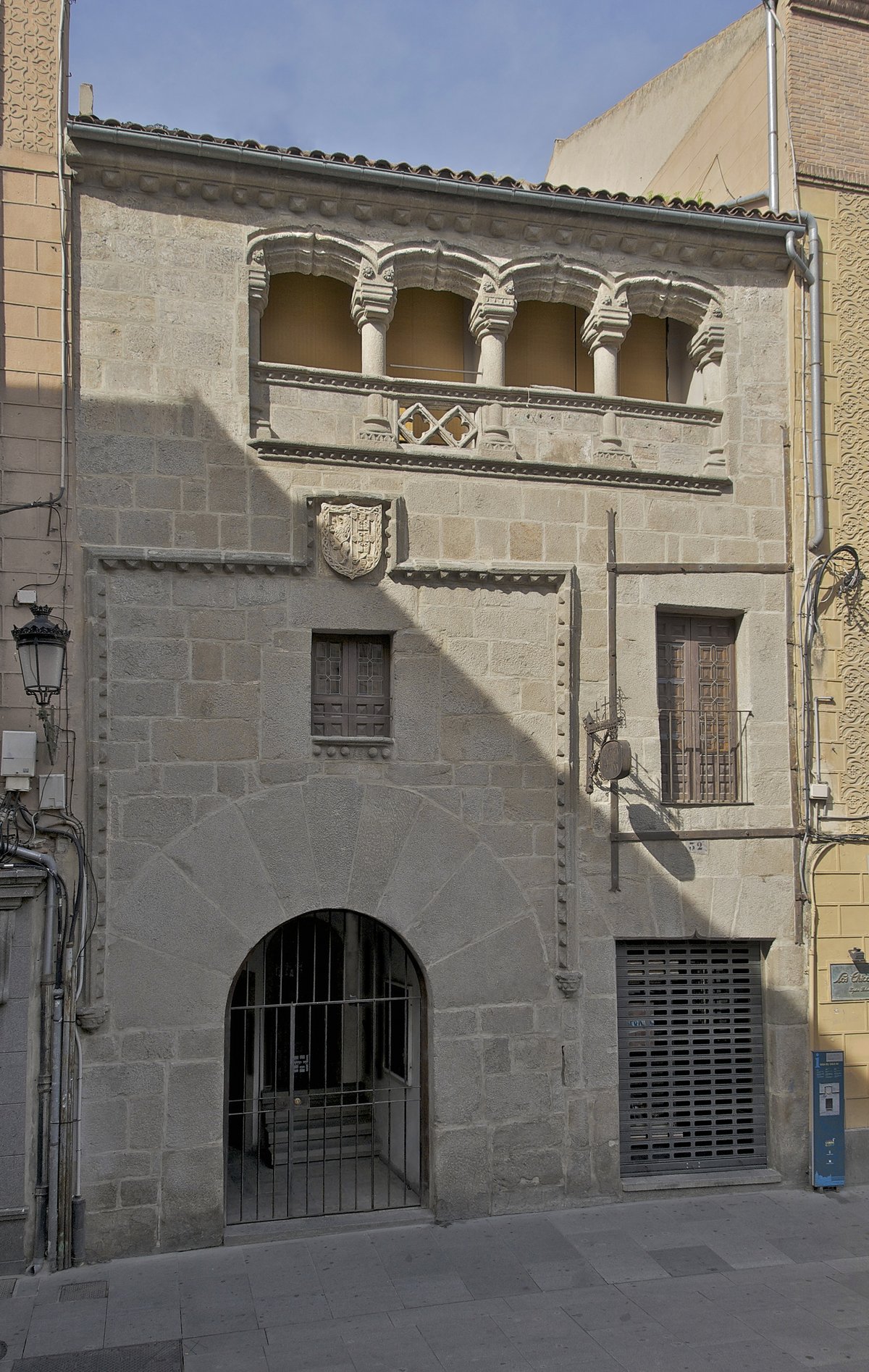
Casa de Juan Bravo, Segovia: Visiting Hours, Tickets, and Historical Sites Guide
Date: 14/06/2025
Introduction
Nestled in the heart of Segovia’s UNESCO-listed historic center, Casa de Juan Bravo stands as one of the city’s most notable architectural and cultural landmarks. Famed for its Renaissance façade and deep connections to the Revolt of the Comuneros, the building exemplifies the intersection of noble heritage, civic pride, and evolving urban life in Castile. Although its interior is currently closed to visitors due to adaptive reuse, its story, exterior, and surrounding sites continue to draw history enthusiasts, architecture lovers, and travelers from around the world (The Tour Guy; Evendo; Turismo de Segovia).
This guide provides a comprehensive overview of Casa de Juan Bravo’s historical and architectural significance, details on visiting hours and ticketing, updates on current access, and recommendations for nearby attractions—all curated to help you make the most of your Segovia experience.
Table of Contents
- Historical Overview and Architectural Context
- Juan Bravo and the Revolt of the Comuneros
- Visiting Hours, Tickets, and Accessibility
- Nearby Attractions and Practical Travel Tips
- Preservation, Adaptive Reuse, and Community Impact
- Frequently Asked Questions (FAQ)
- Conclusion and Recommendations
- References and Further Reading
Historical Overview and Architectural Context
Casa de Juan Bravo, also known locally as Casa del Siglo XV, is an emblematic Renaissance palacete located at Calle Juan Bravo, 32, in Segovia’s historic core (Turismo de Segovia). Constructed in the late 15th or early 16th century amid Segovia’s economic prosperity, the building originally belonged to the Tordesillas family and subsequently to the Vázquez de Cepeda and Tapia families, whose coats of arms still decorate the façade (Acueducto2).
Architectural Features
- Façade: Noted for its granite doorway and plateresque upper gallery, the building is a prime example of late Gothic and early Renaissance architecture. The exterior is embellished with pyramid-shaped reliefs and detailed stonework, typical of Segovian nobility.
- Interior Courtyard: Traditionally, noble residences in Segovia were arranged around a central courtyard with arcades. Although the interior is now closed, the structure once hosted cultural events in its elegant inner spaces.
- Location: Its address on Calle Juan Bravo, a principal thoroughfare, underlines its prominence and accessibility in Segovia’s urban fabric (The Tour Guy).
Juan Bravo and the Revolt of the Comuneros
While popularly linked to Juan Bravo (1483–1521), a key leader in the Revolt of the Comuneros—a 16th-century uprising against the policies of King Charles I—Casa de Juan Bravo was not his family residence (Wikipedia: Juan Bravo; Turismo de Segovia). Nonetheless, the association endures due to the building’s location and symbolic significance. The street and nearby monument to Bravo serve as focal points for the city’s collective memory and annual commemorations, reinforcing the narrative of Segovia’s enduring civic spirit.
Visiting Hours, Tickets, and Accessibility
Current Status (As of June 2025)
Casa de Juan Bravo is closed to interior visits. Following its sale in 2024 and ongoing renovation, the building is being converted into tourist apartments (pisos turísticos) and is not open for cultural events, art exhibitions, or guided interior tours (Turismo de Segovia; OK Diario).
Exterior Viewing
- Access: The façade is fully visible from the street and remains a popular stop on walking tours of Segovia’s historic center.
- Accessibility: The building is centrally located, with level access for exterior viewing. The surrounding streets are pedestrian-friendly.
Tickets
- Current Policy: No tickets are required or available as the interior is closed.
- Future Access: Should the interior reopen in a cultural capacity, ticketing information will be provided by the official Segovia tourism website.
Visiting Hours
- Exterior Viewing: Available at all times; ideal to visit during daylight for photography.
- Interior Access: Not available until further notice.
Guided Tours
While interior access is restricted, many city walking tours include information about Casa de Juan Bravo’s history and architectural significance as part of broader explorations of Segovia’s UNESCO World Heritage center (Nomads Travel Guide).
Nearby Attractions and Practical Travel Tips
Top Nearby Sites
- Plaza de Medina del Campo: Features the monument to Juan Bravo and hosts frequent civic and cultural events.
- Church of San Martín: A Romanesque architectural gem adjacent to Casa de Juan Bravo.
- Roman Aqueduct: Segovia’s most famous landmark, a short walk away (Spain Life Exclusive).
- Casa de los Picos: Renowned for its diamond-shaped stonework, reflecting similar Renaissance tastes.
Getting There
- On Foot: Most sites are easily reached on foot from any point in Segovia’s old town.
- Parking: Limited public parking is available near Plaza Mayor; visitors are encouraged to use public transport or walk.
- Public Transport: Local buses connect Segovia’s train and bus stations with the city center. The area around Plaza Mayor is well-serviced.
Practical Tips
- Best Times to Visit: Early mornings and late afternoons offer the best light for photography and a quieter atmosphere.
- Photo Opportunities: The façade of Casa de Juan Bravo and the lively nearby plazas are ideal spots.
- Cultural Events: Check local listings or the Segovia tourism website for updates on festivals, concerts, or commemorations held near the monument.
Preservation, Adaptive Reuse, and Community Impact
Recent Developments
Due to rising maintenance costs and changing economic realities, Casa de Juan Bravo was sold in 2024, ending its decades-long role as a contemporary art gallery and cultural hub. Its conversion to tourist apartments is designed to preserve its Renaissance façade and key features while ensuring its sustainable upkeep (Acueducto2).
Heritage Management
- Preservation Focus: The adaptive reuse project prioritizes the integrity of the Renaissance exterior, with input from heritage authorities to maintain the building’s visual and historical significance (Turismo de Segovia).
- Community Response: The transition has been met with both nostalgia for the building’s cultural legacy and support for its continued preservation. The Fundación Arte, Cultura y Patrimonio marked the closure with a commemorative exhibition.
Civic Identity
Casa de Juan Bravo, together with the monument to Juan Bravo in Plaza de Medina del Campo, anchors Segovia’s traditions of civic engagement, public memory, and cultural life (Evendo). Annual commemorations, educational programs, and street performances help keep the legacy of the Comuneros and Segovia’s unique history alive for residents and visitors alike.
Frequently Asked Questions (FAQ)
Q: Can I visit the interior of Casa de Juan Bravo?
A: No, as of June 2025, the interior is closed for renovations and conversion into tourist apartments.
Q: Are there guided tours available?
A: Interior tours are not available, but the exterior is featured on many Segovia historical walking tours.
Q: Is there an entrance fee?
A: No tickets are required for viewing the exterior. The interior is not accessible.
Q: Is Casa de Juan Bravo accessible for people with disabilities?
A: The building’s exterior can be viewed from the street, which is generally accessible. Interior adaptations are pending the completion of renovations.
Q: What are the nearest attractions?
A: Plaza de Medina del Campo, Church of San Martín, Roman Aqueduct, and Casa de los Picos are all within easy walking distance.
Q: Is there current information on COVID-19 restrictions?
A: Check the official Segovia tourism website for the latest updates on health and safety measures.
Conclusion and Recommendations
Although Casa de Juan Bravo’s interior remains closed, its richly ornamented Renaissance façade, central urban setting, and deep historical associations make it an essential stop in any Segovia itinerary. Its story—intertwined with the legacy of the Comuneros, the evolution of Segovian urban life, and ongoing preservation efforts—offers valuable insights into Spain’s medieval and early modern heritage.
Visitors are encouraged to admire the building as part of a broader exploration of Segovia’s historic quarter: stroll along Calle Juan Bravo, visit nearby squares and monuments, and immerse yourself in the city’s vibrant street life. For up-to-date travel information, guided tour options, and cultural programming, consult the official tourism website and consider using the Audiala app for enhanced cultural engagement.
References and Further Reading
- Nomads Travel Guide: Self-Guided Walking Tour of Segovia
- The Tour Guy: Top Things to See in Segovia
- Evendo: Casa de los Picos and Monumento a Juan Bravo
- Spain Life Exclusive: Segovia’s Most Famous Aqueduct
- Turismo de Segovia: Casa del Siglo XV
- Acueducto2: Casa de Juan Bravo’s Adaptive Reuse
- Wikipedia: Juan Bravo
- Chasing the Long Road: Things to do in Segovia
Discover more: For the latest updates, cultural listings, and guided experiences, visit the official Segovia tourism website and follow local event calendars.
Plan ahead: Download the Audiala app for interactive guides, real-time travel tips, and curated content on Segovia’s historic sites.
